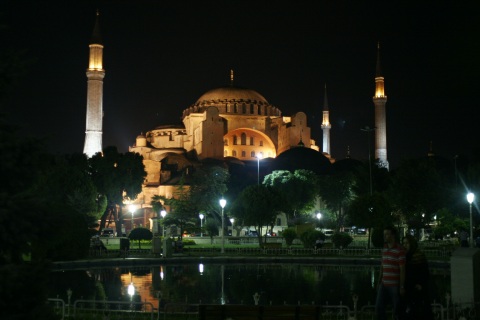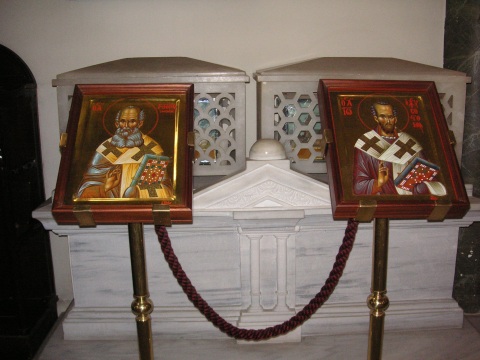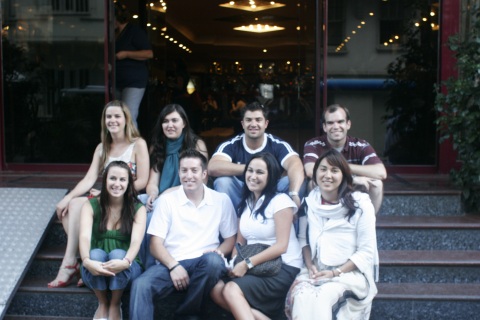

September 11, 2007

Agia Sophia illuminated at night. (Photo taken by Patriarchal Youth Conference attendee Natalie Schrik, a recent graduate of San Francisco State University with a degree in Journalism.)
The Second International Orthodox Youth Conference, held July 11 - 16 in Constantinople, was attended by more than 1,000 Orthodox Christian youth from throughout the world. The Metropolis of San Francisco was represented by 10 outstanding young adults who chronicled their experiences at this historic event: Niko Bekris, St. Demetrios, Seattle, WA, who is a Senior at Holy Cross School of Theology in Brookline, MA; Elenique Changaris, St. Anna, Roseville, CA; Kalianthe Changaris, St. Anna, Roseville, CA; Thomas Felactu, St. Katherine, Redondo Beach, CA; Paul Fontes, St. Basil, San Jose, CA; Samuel Johnson, St. Anna, Roseville, CA, who is also a student at Hellenic College, Brookline, MA; Natalie Schrik, Annunciation Cathedral, San Francisco, CA; Nicole Smyrnis, St. Anna, Roseville, CA, who is also a student at Hellenic College in Brookline, MA; Nicolas Vardiabasis, St. George, Downey CA; and Theresa Vorgias, St. Anthony, Pasadena CA.
This year's conference followed the theme "Members of the Church - Citizens of the World", and was organized by the Patriarchate, with the blessings of His All Holiness Ecumenical Patriarch Bartholomew. Conference attendees were provided with accommodations during their stay at the Istanbul Hilton Conference Center, but were required to raise funds to defray their expenses for air travel, meals and other incidentals. Members of the Metropolis of San Francisco delegation sent out personal fundraising appeals to family, friends and parishioners, and held various fundraising events to generate the support needed so that they could participate in this conference.
From the Journal of Elenique
Changaris, Kali Changaris, Sam Johnson and Nikki Smyrni:
The
conference began with a speech by His All Holiness Patriarch
Bartholomew. The following three days were spent in conferences with
24 different speakers, ranging from Professors, Deacons, Priests,
Archmandrites and Bishops. Different topics were discussed that all
centered around the theme of "Members of the Church - Citizens of
the World". They all reinforced the importance of keeping
Orthodoxy in our everyday lives and that we are all one Church.
Whether trying to break down the barriers of language, cultural
differences, or miles of land we are able to achieve unity through
faith and come together as one body united by Christ.
This journey was one that encompassed the past, present, and the future situation of the church. A continual question was raised, "Are the youth the future of the Church or is the Church the future of the youth?" The answer was simply "yes". We are the future of the church and the Church must also be our future. Without this we are just lost in a world of conformity. We are all called to take up our crosses and stand out in a society that has failed to recognize the presence of the Orthodox faith.
From the Journal of Niko Bekris:
I found it very depressing to see that
the once capital of Christendom- not just east or west- the once
proud Byzantium, with its famous churches after which all Greek
Orthodox liturgies and architecture had been modeled after, was now
in a state of captivity. While in the City I was told by one of our
tour guides that there are now almost 3,000 mosques in Istanbul, and
2,800 of them had been Orthodox churches at one time. We were even
taken on tours of the great mother-church of Agia Sophia, as well as
the former monastery of Chora and the island of Halki (where there
used to be an active seminary which produced the Patriarchs of
Constantinople until 1972), only to find that each one had been
closed to worship and were now being used either as museums or simply
empty edifices. I was shocked to see that many of the icons on the
walls of these former churches had either been painted over, defaced,
or had eyes scratched out. On top of this, while looking at the icon
of the Platytera in Agia Sophia (one of the few icons left intact in
this church), our group was told that prayer in these buildings was
prohibited to all people (Christian, Muslim or anyone else). Some of
us had very softly begun chanting "Ti Ipermaho," when a security
guard angrily came and told us to stop. It brought my heart to a
deep sorrow to see these tragedies.
I experienced many beautiful things in Constantinople and also witnessed some very sad things. In the end, I felt my experience to have been bittersweet, but I was not without hope for the future. I hope that one day Christianity can exist in Turkey- not at the expense of any other faith, but with the same freedom that we enjoy here in America. As St. Paul says in his second Epistle to the Corinthians, we look for "encouragement and hope in times of trouble, through Christ." (1:3-7) For myself, I look forward to finishing Seminary this coming year, and returning to our Metropolis to do whatever work God has in store for me, while remembering the lessons I learned in Constantinople this summer.
From the Journal of Natalie
Schrik:
My
favorite moment in Constantinople was arriving early to Divine
Liturgy with all of the people from our Metropolis, getting lost, and
finding our way to St. George Church on Sunday morning, the day
before our departure. We'd decided to not wait with the
conference-goers to take us to the church by charter bus, instead,
our ambitious group from the Metropolis of San Francisco decided to
take a cab and beat the 1,000 person crowd, and make sure we had a
seat in church, which we had heard held less than 200.
Dropped off by our taxi driver, there was no visible entrance to the church, only a very high wall with barbed-wire fencing. This, we assumed was a local prison, so finding the church was not going to be easy. We walked around the perimeter of these walls for close to thirty minutes without any direction or idea where to go. Some in the group were noticeably worried and started to cry for not having any direction. The directions we eventually got led us straight back to the main road. Even when asking for help with direction, we'd been jeered by some restaurant workers. That Sunday, I'd felt unwelcome not for being a foreigner, but for being a Christian.
We'd finally stopped at a large metal gate, rang the bell, and out came a young man. A resident guard, he looked at everyone in our group, and nodded for us to come in. He showed us into a church courtyard. According to a Greek Consulate official in Turkey, this young man was one of the last 300 remaining Orthodox youth who decided to stay in Constantinople. As he took us into the Church, we passed an empty office displaying two framed pictures hanging on the wall, one of His All Holiness Patriarch Bartholomew, and another framed photo of Ataturk, the founder of the Turkish Republic and its first President.
We finally reached our destination of the St. George church at the Patriarchate, and even managed to arrive before Orthros. The church of St. George was full of relics. To the left were the icons of two male saints. Though I couldn't read their names, I stopped to pray in front of them. There have been few times in my life where I have felt the presence of holiness, and I could sense that this was sacred and holy ground. I realized that I was standing in front of the relics of St. John Chrysostom and St. Gregory the Theologian. It also was a strong reminder to me that no matter how far I have strayed from the Church, in journey, but especially in sin, Christ's love exists, and is alive here in this place.

The relics of St. Gregory the Theologian and St. John Chrysostom at the Church of St. George at the Ecumenical Patriarchate. (Photo courtesy of Thomas Felactu.)

Young adults attending this trip from the Metropolis of San Francisco included: (front row) Kalianthe Changaris, Samuel Johnson, Theresa Vorgias, Natalie Schrik; (back row) Elenique Changaris, Nicole Smyrnis, Thomas Felactu, Paul Fontes. (Not pictured: Niko Bekris and Nicolas Vardiabasis)
4th Thursday after Pascha
